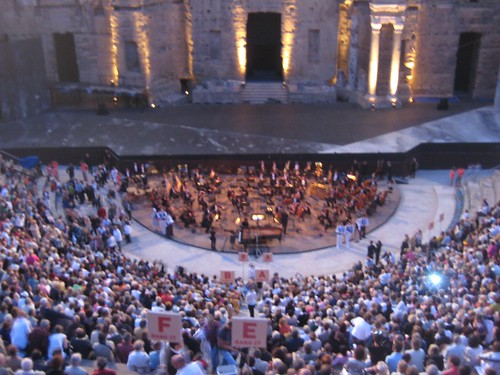I'm continually amazed that these Roman edifices are still used for their original purposes 2000 years later. So, I thought I would try to put myself in the position of a Roman attending one of the earliest performances at the Theatre d'Orange.

-- begin dream sequence --
On a breezy summer day in A.D. 60, a Roman merchant was hastily deconstructing his vegetable stall in the city of Orange. It had been a busy day at the market and his mind was elsewhere. Today would be his first opportunity to catch a play at the recently opened theater.
It was the talk of the town. Even the hard-to-impress Gauls had described the edifice with a magical reverence. The theater dwarfed the other buildings in town. It so loomed over the adjacent temple that some of the lower castes whispered that the Cesar must be more powerful than the gods. Who else could command the hillside to spew forth rock and stone in such order to create the massive stage wall?
The merchant simply couldn't miss this opportunity to marvel from within the theater walls. He was looking toward the opportunity to mingle with his peers and possibly hurl an insult or two at the senators seated in the front rows. The theater was known to be the best venue for judging your place in society. There were no entrance fees for citizens of Orange, but seating was strictly enforced by class. However, all were welcome at the theater. Women could sit with their husbands. And even the slaves could peer into the theater from the ridge just above the last formal seating rows.
Getting to your seat in time meant leaving the house early. When the final call to start the program sounded, the merchant did not want to be left queuing outside. As it was, he would have a difficult time getting around town, since the streets around the theater would be restricted to theater-goers. If he was early, on the other hand, there would be an opportunity to relax and have a drink at one of the many cafés in the area.
Half an hour before the show, the merchant and his wife arrived at the gates of the theater. Not yet accomplished enough to warrant a seat in the lower bowl, they ascended the steps to the upper balconies. The steps were steep, slowing older patrons - some had to rest half way up. Bounding up the final step and entering through the vomitorium the merchant was rewarded with a breathtaking view.
Gazing into the stands from across the stage was the visage of the Emperor. His statue clearly signaled that this theater was a product of Rome. Flanking the doppelganger to each side were elaborate colonnades and false balconies, comprising the stage wall. The two front corners of the theater were stabilized by masonry towers. The merchant could imagine the actors preparing for the show in these wings. Over head, long cloth banners spanned the length of the theater providing welcome shade from the hot sun.
To be continued... (maybe)
View more of my photos of Orange at flickr.
![Reblog this post [with Zemanta]](http://img.zemanta.com/reblog_e.png?x-id=afff42a4-7c52-4b81-beb1-c9f21c3d45c4)

No comments:
Post a Comment